About the Boat
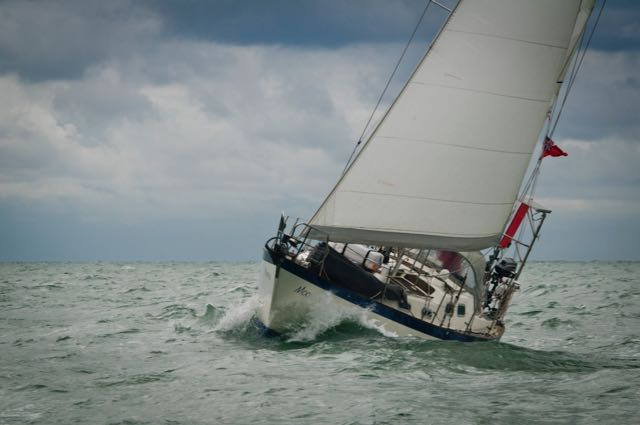
Introduction
Moonrise is a Vancouver 32. All boats are compromises but Moonrise is less of one than most. It does not pretend to be a racer or even a cruiser-racer. It’s not particularly well suited to weekend sailing and not at all for entertaining or parties. It’s an out-and-out ocean-going, long-distance, short-handed cruiser. It doesn’t do much else but it does that very well indeed. It’s a heavy displacement long-keeler with a transom-hung rudder, a tiller, wind-vane steering and a cutter rig. There’s lots of stowage and its heavy displacement means loading it up does not diminish its performance. There’s no air-conditioning, second bathroom or underwater lighting but there are Dorade vents, mast steps, security bars round the mast and good sea berths with lee cloths.
Note for Normal People
For those looking for photos of the sitting room, kitchen, bedroom and bathroom, they’re further down. Most of this first part is for boat nerds.
Vital Statistics
Built in 1990 by Northshore in England
Hull number 60 (of the 62 that were made)
Length overall 9.75m or 32’
Length at waterline 8.38m or 27.5’
Beam 3.22m or 10.58’
Draft 1.37m or 4.50’
Hull speed 7.3 knots
(calculated as 1.4 x √LWL and seems right in practice)
Displacement 6,600Kg or 14,500lbs
Ballast 2,700Kg or 6,000lbs
Mast height 12.8m or 42’ above the water
Sail area 56m2 or 600 square feet
Water 360 litres
Engine Yanmar 3GM30F 24hp
Fuel 180 litres
Consumption 1.4L/h @ 2,000rpm (5.3 days on a full tank or 480M at 4 knots)
2.0L/h @ 3,000rpm (3.7 days on a full tank or 360M at 4 knots)
Gas 2 x 3.9Kg and 1 x 2.75Kg
Hull
The hull is hand laid up GRP. A combination of woven roving and chopped strand mat are used with thickness increasing towards the keel. There’s a reinforcing balsa core in the topsides which stops at the waterline. The ballast keel is encapsulated entirely within the hull moulding. The deck moulding has a balsa core, replaced with plywood in high-stress areas.
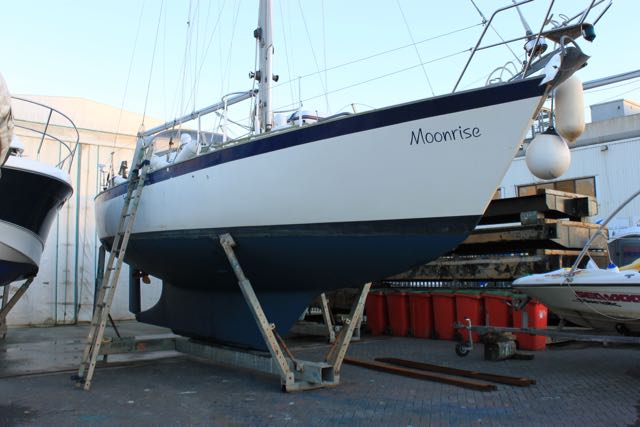
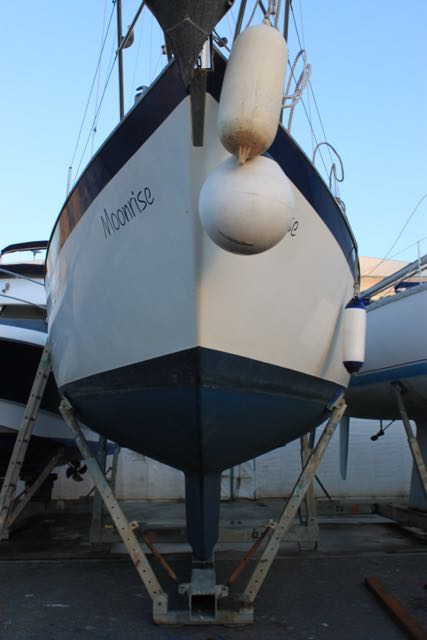
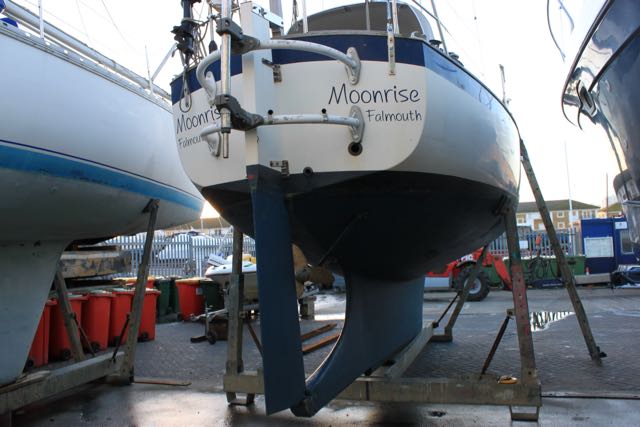

Rig and Sails
Moonrise has a cutter rig. In light airs all plain sail keeps the boat moving. In more moderate conditions a reefed jib, full staysail and reefed main is perfect and in heavy weather the staysail paired with a deeply reefed main is a superb combination.
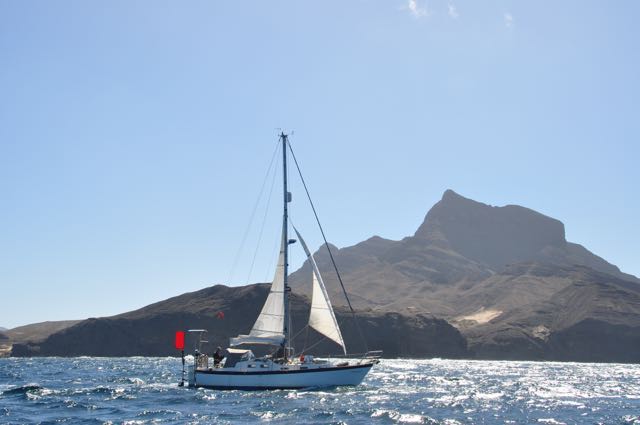
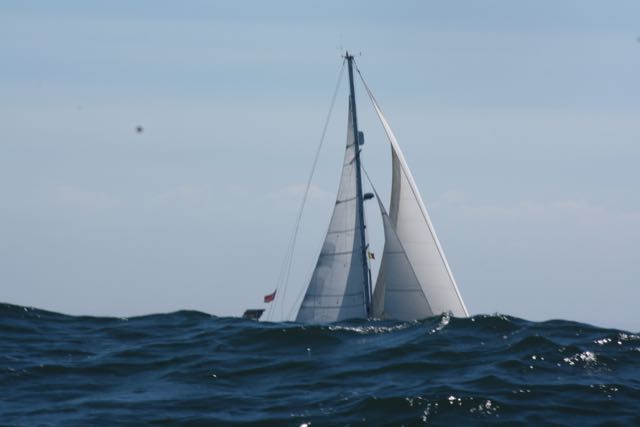

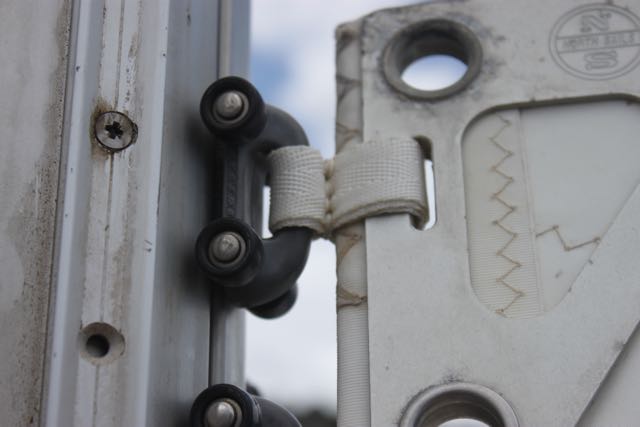
Rig
Forestay and inner forestay
Two spreaders, cap shrouds, intermediates and fore and aft lowers
Twin backstays
Running backstays.
Spare standing rigging of Dyneema with block-and-tackle tensioning
Spares for all running rigging made-up and ready to go
Security bars around the mast
Two mast-mounted halyard winches with six clutches and cleats
One mast-mounted reefing winch
Telescopic mast-mounted spinnaker pole
Clutches for pole car up-haul and down-haul
Lazy-jacks
Folding mast steps
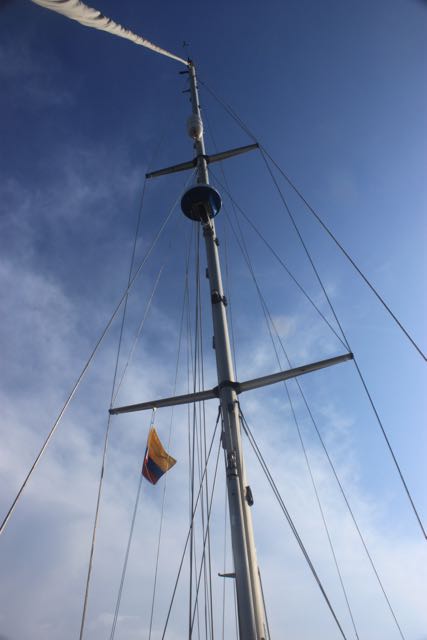


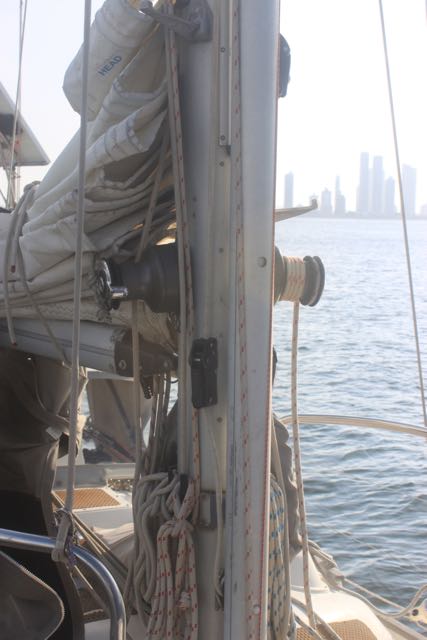
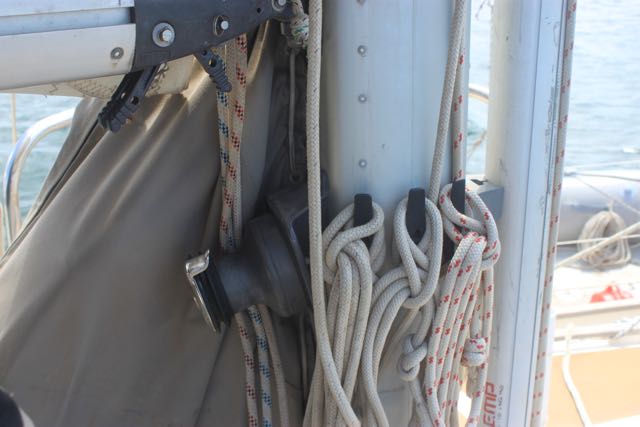
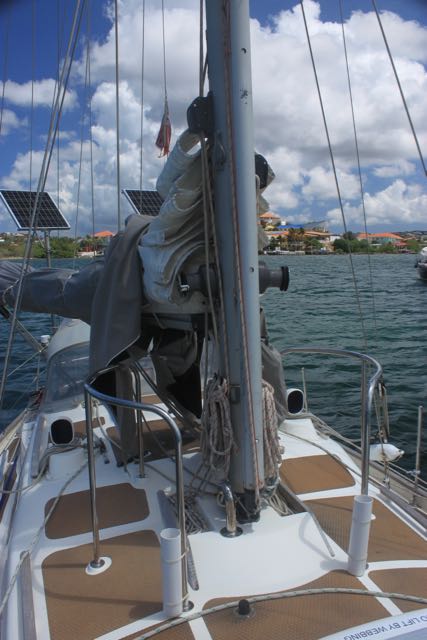

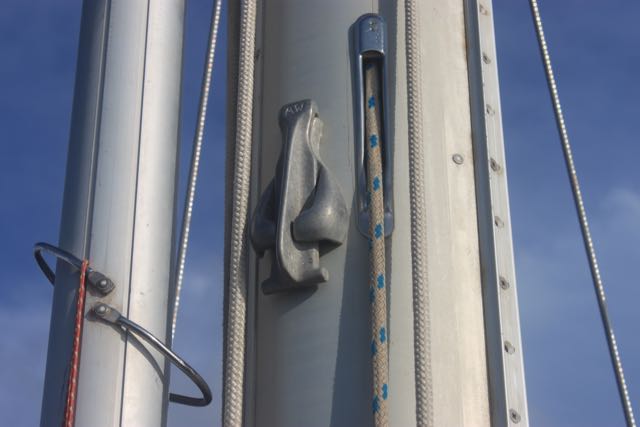
Sails
I 13.72m or 45.00’
J 4.66m or 15.3’
P 11.98m or 39.3’
E 3.60m or 11.8’
Mainsail fully battened with three reefs
Staysail hanked-on with no reefs
Yankee roller-furling
Spare mainsail
Spare staysail
Spare yankee
Cruising chute
Trysail on separate mast track
Storm jib hanks on in place of staysail
Cockpit
The cockpit is small. It’s perfect for single-handed sailing, with everything close to hand. It’s okay for double-handers but if there’s any more than two in the cockpit it’s best if someone goes below during tacks and gybes or they’ll be in the way. This is not a boat for a big crew.
There are six winches in the cockpit, three each side, for the staysail sheets, jib sheets and spinnaker sheets. The spinnaker winches are also used for the gybe preventers that are permanently rigged, one each side. The kicker is tightened using one of the staysail sheet winches. All halyards, the topping lift and the reefing lines are at the mast.
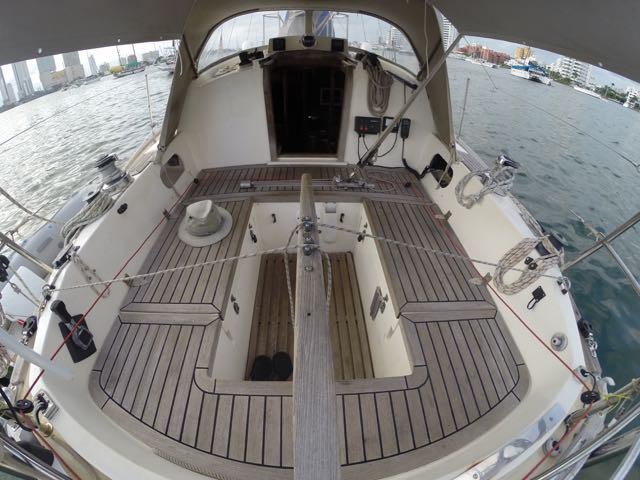
The awning is a rectangle of canvass that may be tied to the spray-hood and backstays. It provides shelter from the sun and collects rainwater. It works well enough and I like its rugged simplicity.
The transom-hung rudder is operated by a simple tiller. The wind vane, which has its own separate rudder, is adjusted by means of a continuous line that runs right round the cockpit so I can reach it from wherever I am, even from inside the companionway. This works really well.
There is a steering compass and displays for the depth sounder, speed log and wind instruments, and a remote control mic for the main ship’s VHF.
I use the wind vane almost all the time but there is also a basic, stand-alone, electronic autopilot for use when motoring or in congested or inshore waters. I have a spare control unit and two spare drive units.
Ground Tackle
Bower anchor Manusun 16Kg (35lb) on 60m of 10mm chain
Spare bower CQR 16Kg (35lb) on 11m of 10mm chain and 100m of nylon
Kedge anchor Fortress FX-11 on 3m of 6mm chain and 50m of nylon
Spare kedge Danforth 6.3Kg (14lb) on 8m of 6mm chain and 30m of nylon
Windlass Manual
Snubber 6m of nylon with chain hook
Warps 2 x 10m, 2 x 15m, 2 x 20m, 2 x 50m.
Fenders 8
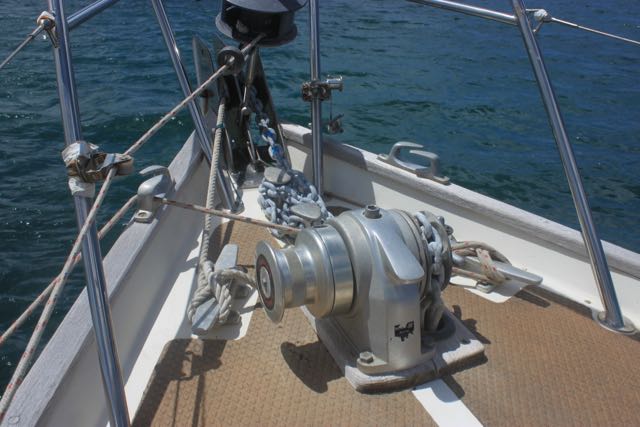
Water
There are three main water tanks under the cabin sole. The forward two are connected together and between them hold 125 litres. The aft tank also holds 125 litres. There’s an additional 60 litres in portable containers that not only provide extra capacity but also enable the tanks to be filled by ferrying water from the dock by dinghy. They may also be taken into the life raft should I abandon ship. Two containers are kept with the grab-bag for this purpose. They are fitted with lanyards and retro-reflective tape and are not completely filled so that they will float.
The forward tanks are filled via one filler pipe, the aft tank via another. Inadvertently taking-on contaminated water thus only affects either the forward tanks or the aft tank but not both. All three tanks contain ceramic beads coated in chemicals that slowly leech into the water to sterilize it.
There are two fresh water taps, one in the galley and one in the bathroom. The one in the galley is fed via a charcoal filter. Both taps are operated by foot pumps. Water to the taps may be switched to come from the forward tanks or the aft tank. On a long passage I switch back and forth between the tanks so that my water supply is always divided roughly evenly between the forward and aft tanks. Thus if a tank should leak or become contaminated only half my water supply would be lost. In port I keep one tank filled with known good water while using and refilling the other from shore.
In addition to the two fresh water taps there is a salt-water tap in the galley, operated by a foot-pump that’s identical to the other two. Because all three foot pumps are the same I only need one set of spares and, should they be used up, one pump can be cannibalised to fix another.
The cockpit sun awning is fitted with a rain catchment trunk. In a tropical downpour it’s easy to collect a lot of water very quickly, and it tastes great!
There is a pressurised hot and cold water system though if I didn’t have it I wouldn’t install one. It’s always switched off.
Galley
The cooker runs on gas. I have three gas bottles, each seems to last about a month. The fridge is electric.
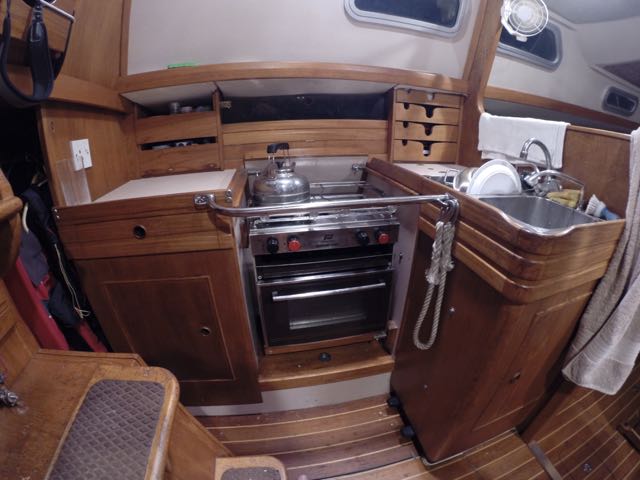
Next to the companionway is a wet locker that drains into the bilge. In it are kept oilskins, sea boots, harnesses and lifejackets.
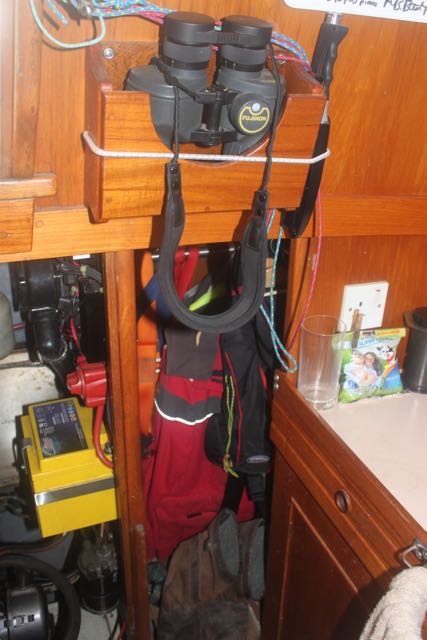
Cabin
Under the bunk is a large stowage area that’s mostly occupied by sails, water containers and spare rigging. There’s a wardrobe, a cupboard, a Dorade vent and a cooling fan. The hatch has an insect screen and a wind scoop that’s absolutely brilliant. In port it keeps the whole boat cool even when it’s roasting hot outside.

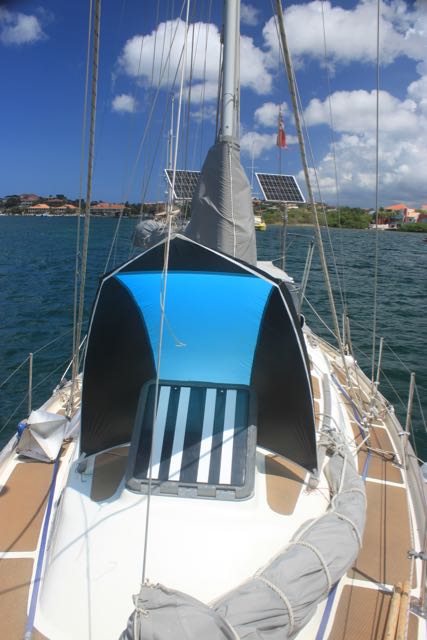
Bathroom
There is pressurised hot and cold running water and a shower but, as noted elsewhere, I don’t use these. I use the fresh water foot pump. There is also a stainless steel holding tank.

Saloon
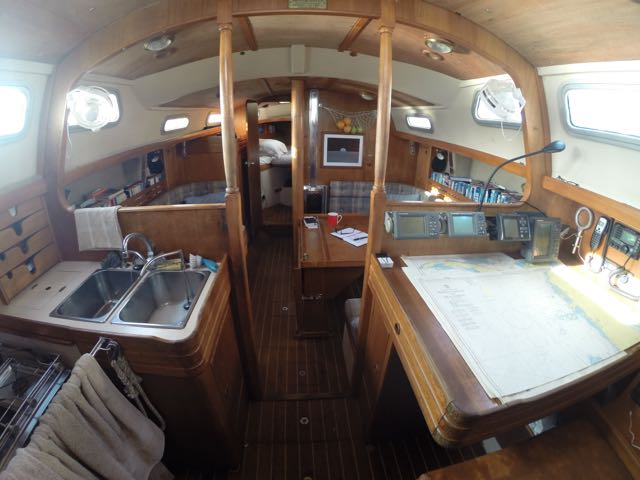
DCIM100GOPRO
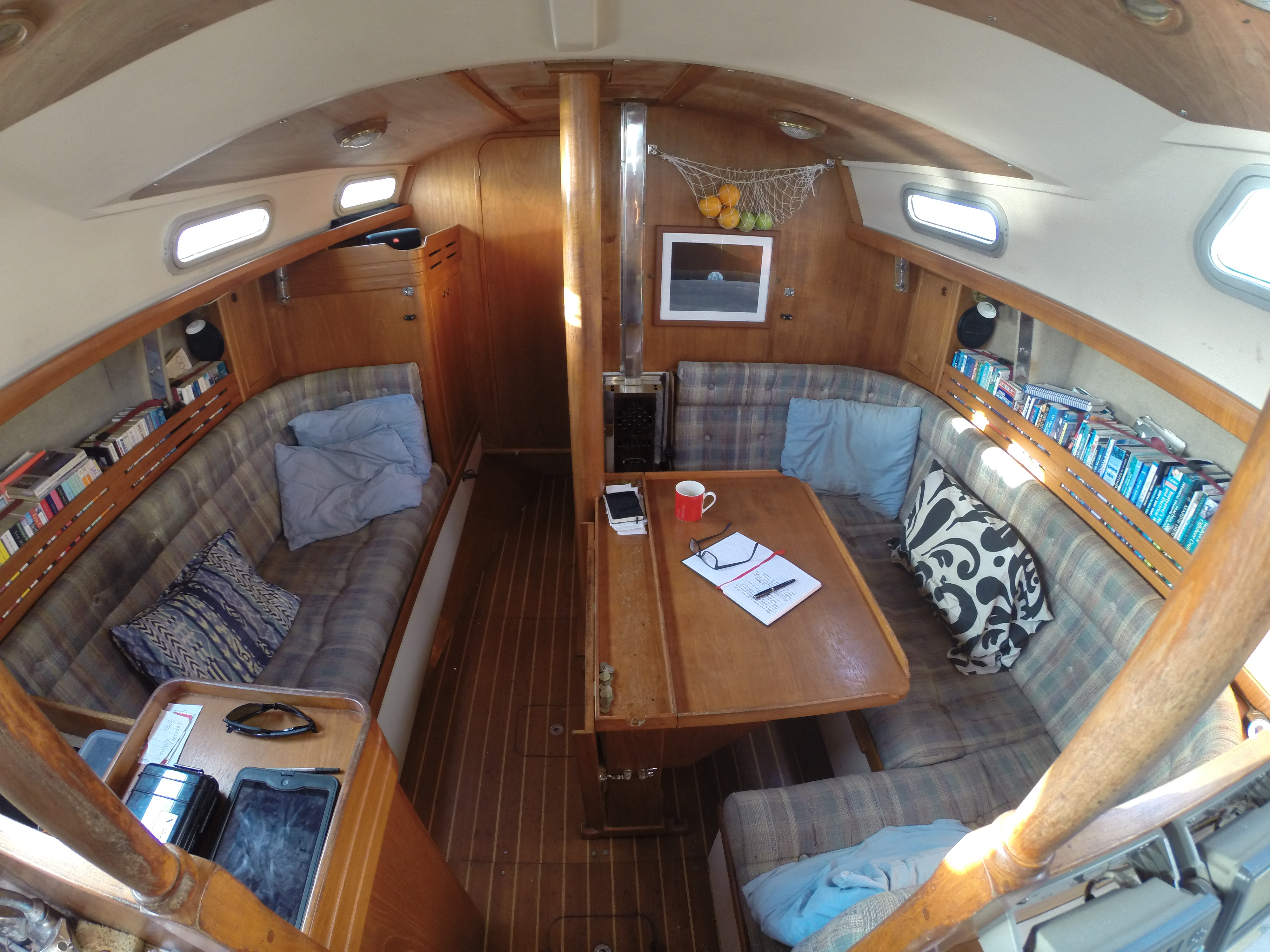
The saloon table is where everything happens. Meals are eaten, books are read, diaries are written, bits of the engine are dismantled, fixed and reassembled, just about everything is done here.
There are two good sea berths. They’re in the middle of the boat, the most comfortable place when at sea. Both are fitted with lee-cloths that are secured using cleats. These are easier to release than knots.
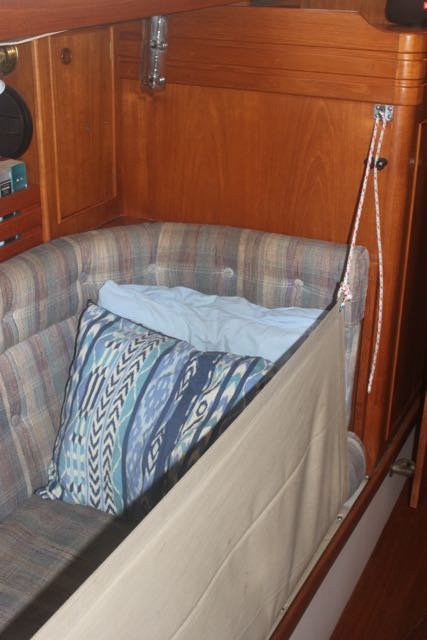
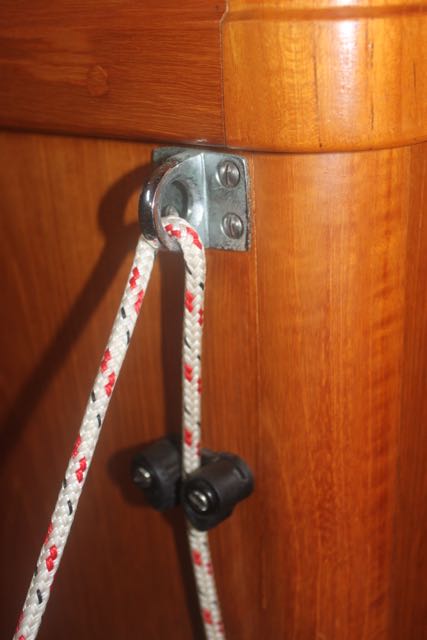
The heater runs on paraffin. Even when there’s snow on the decks it keeps the boat toasty. It creates a lovely dry heat, similar to that of an open fire, and makes a rather nice, homely shhhh noise. I like it.
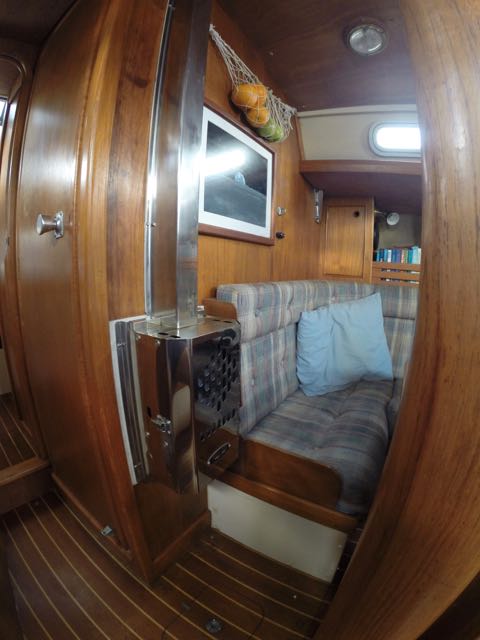
In addition to the one for the cabin and the one for the bathroom there are two Dorade vents for the saloon. They let in air from outside even when all the hatches are closed and have, thus far at least, never let in any water. There are also two cooling fans, one for each sea berth, which can also be used for the galley and chart table. They consume little power and are quiet so they can be left on all night. When it’s hot they’re great.
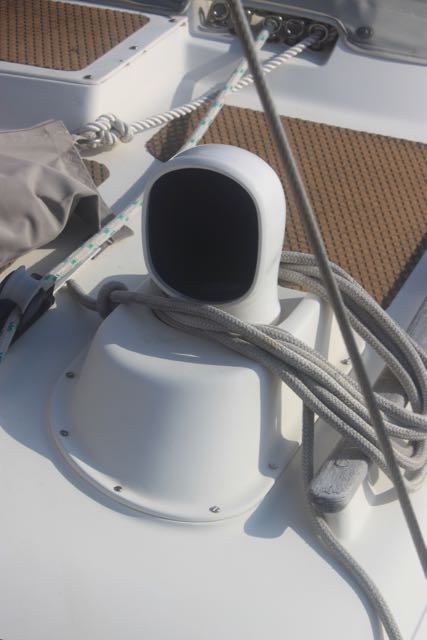
Dinghy
Moonrise carries a 2.6m inflatable dinghy. When at sea it’s stowed in a cockpit locker. The dinghy is powered by a 3.5hp outboard. A crane, mounted on the port side, can be used both to lift the dinghy from the depths of the locker (it weighs 28Kg) and to move the outboard between the dinghy and the pushpit where it is stowed. The dinghy is equipped with wooden oars and a small Bruce anchor with a chain and nylon rode.
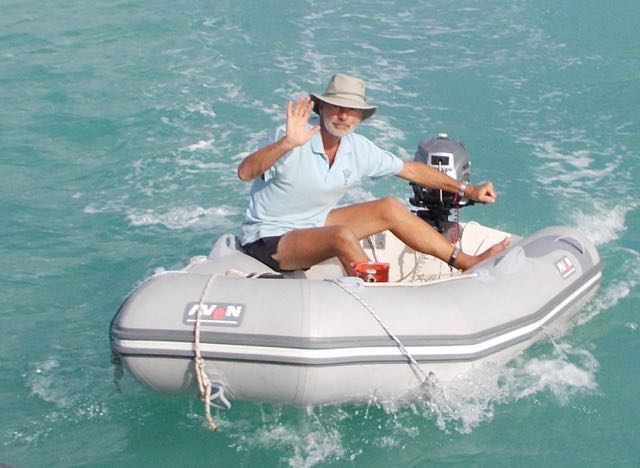

Emergency Precautions
I’m not expecting actually to use these. Their primary function is to reduce anxiety simply by being there.
- A storm jib is stored below. It hanks on to the inner forestay as a direct replacement for the staysail, and uses the staysail’s sheets.
- A trysail with its own separate mast track is stored on deck in a specially made bag with its slides in the track and its sheets tied on, all ready to go. To hoist it I just undo the bag, connect the halyard and pull. I’ve tried this and it works well though it’s easier if you’re on the starboard tack and the track is kept clean and lubricated.
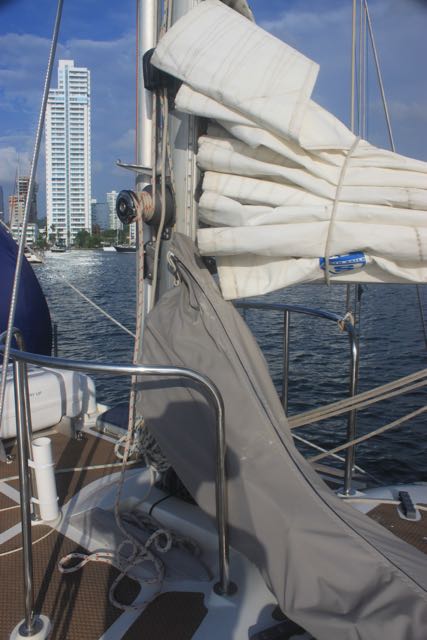
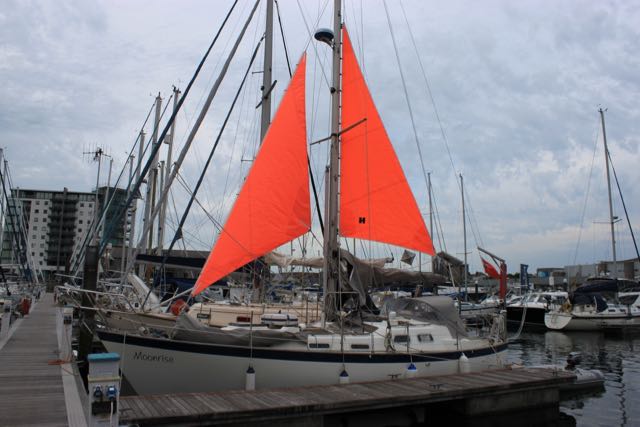
- A series drogue is kept below, flaked into a bag ready for deployment. There is a weight at its aft end and the forward end attaches to a towing bridle that connects to two drogue chainplates installed on the stern for this purpose. In trials I found deployment to be easy but, as might be expected, recovery is a drag.

- The lockers have latches, the batteries are held in place by a retaining bar, the cooker is restrained in its gimbals and the books are held in their bookcases with straps. I should not be showered by heavy objects if Moonrise is knocked down.
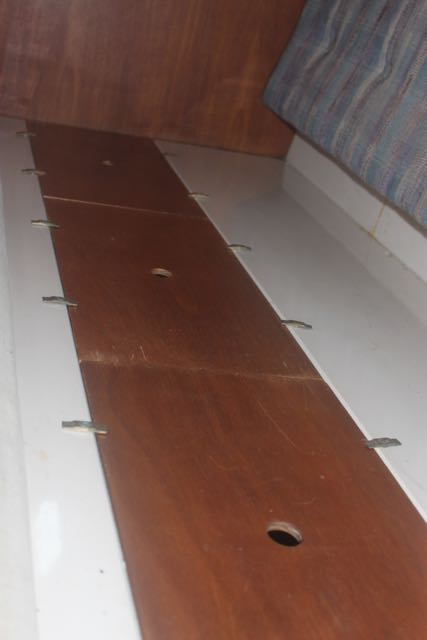
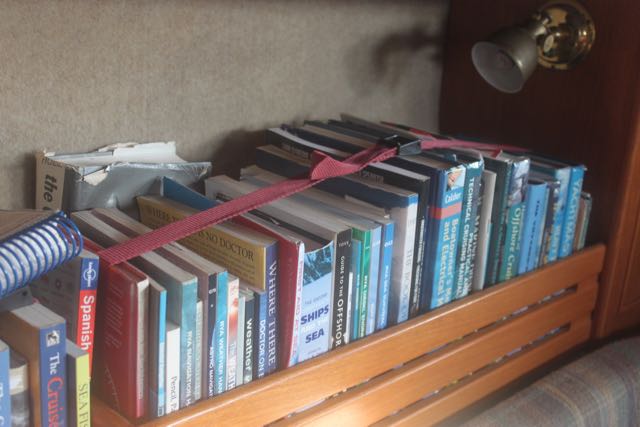
- There are two identical manual bilge pumps, one operated from the cockpit, one from down below. They are the same as the holding tank pump so only one set of spares is needed.
- A crash kit is kept under the chart table, ready to grab. It contains:
- Bolt cutters
- Large hacksaw with spare blades
- Axe
- Wrecking bar
- Claw hammer
- Leak stopping goo
- Wooden bungs (though I’d probably use the goo)
- Foam fire extinguishers and a fire blanket.
- First-aid kit that’s for more than just first aid.
- Medical kit including antibiotics, strong analgesics and several medical books with stomach-churning pictures.
- The satellite phone is primarily an emergency item. I can call Falmouth Coastguard from anywhere in the world and either ask for assistance or be put through to a doctor with whom I can discuss any medical situation that may arise.
- Sextant and associated reference books

- Personal locator beacons
- Masthead strobe
- Two grab tanks of water, 10 litres each, stowed next to grab bag.
- Grab bag containing:
- EPIRB
- Hand held DSC VHF with GPS
- Laser flare
- Handheld strobe
- Batteries
- Portable water maker
- Spectacles
- Torches
- Jack knife
- Lots of other stuff
- Life raft stowed on deck ready to launch
Electrical System
- The 44Ah AGM engine start battery is charged by its own engine-driven alternator, not the main alternator that charges the house battery. This system of starter motor, battery and small alternator is normally isolated from everything else though the battery can be linked to the house batteries if necessary.
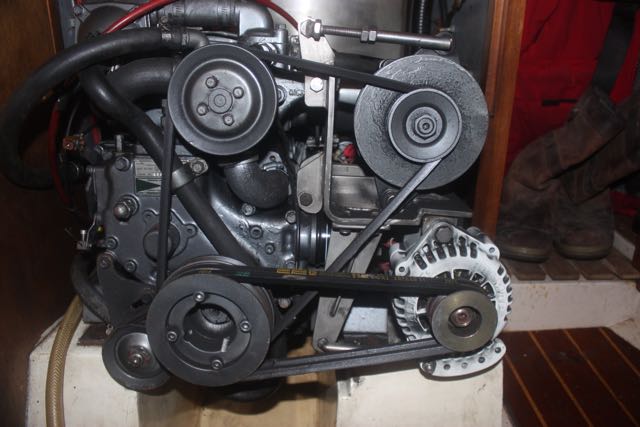
- Three AGM batteries totaling 345Ah form the house bank. They are charged by:
- Two 75W solar panels mounted on poles on the transom. This is not pretty but it is effective, enabling the panels to be pointed at the sun thus increasing their efficacy. The solar panels charge the battery via a MPPT regulator.
- A towed generator with its own regulator.
- A 150A engine-mounted alternator with a smart regulator.
- A shore-power charger.
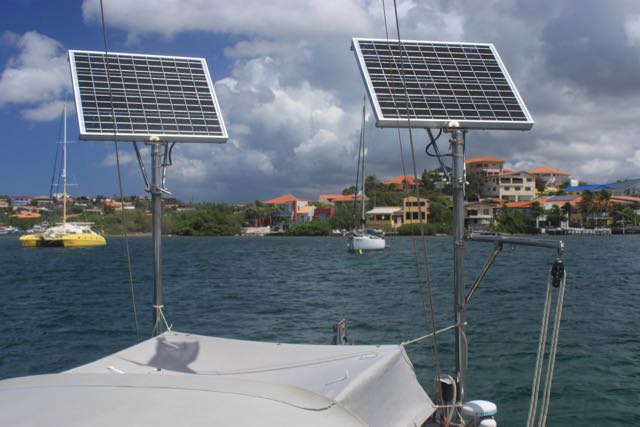
- All the cabin lights and navigation lights (except the steaming light) are LEDs.
- The 350W inverter is beefy enough to enable power tools to be used aboard.
- A battery monitor indicates the state of charge of the domestic bank.
Electronics
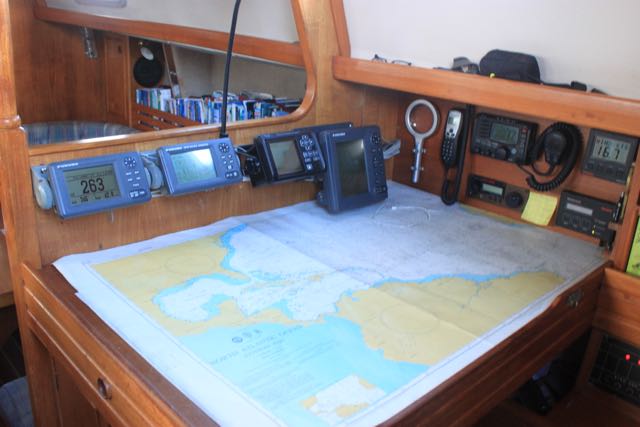
Sailing Instruments
- Depth sounder
- Spare depth sounder with transducer and head unit
- Speed log
- Wind indicator
- Chart table repeater display
- These sailing instruments are interfaced together but not to anything else
Communication
- VHF radio with remote control mic in the cockpit.
- Class B AIS transponder
- The AIS is interfaced with the VHF but not to anything else. This means that:
- The lat and long position from the AIS GPS is displayed on the VHF and used by it for DSC emergency calls and position requests.
- An individual DSC call may be made to an AIS target without having to type its MMSI number into the radio. This has proved to be a useful facility.
- Satellite telephone used only for downloading GRIB files and for plain-text emails.
- SSB receiver with an isolated backstay as an antenna for shortwave broadcast stations, weather faxes and sailors’ nets.
- High gain Wi-Fi antenna for use in port.
Navigation
- GPS
- Spare GPS with head unit, antenna and coax
- Navtex receiver
- Radar
- The GPS, Navtex and radar are interfaced together but not to anything else. This means that:
- The radar shows the lat and long position of its cursor’s position
- The Navtex may be used as an auxiliary GPS data display
- All the instruments, including the VHF, AIS, GPS, Navtex and radar are stand-alone units with their own displays. Each would continue to be usable even if one or all of the others were to fail.
- The sailing instruments’ network, the communication network and the navigation network are all separate from one-another. Should one fail or become corrupted the others would continue to function. The communication and navigation networks both display GPS data, one from the GPS, the other from the AIS.
